FORD F750 2000 10.G Owners Manual
Manufacturer: FORD, Model Year: 2000, Model line: F750, Model: FORD F750 2000 10.GPages: 208, PDF Size: 1.08 MB
Page 181 of 208
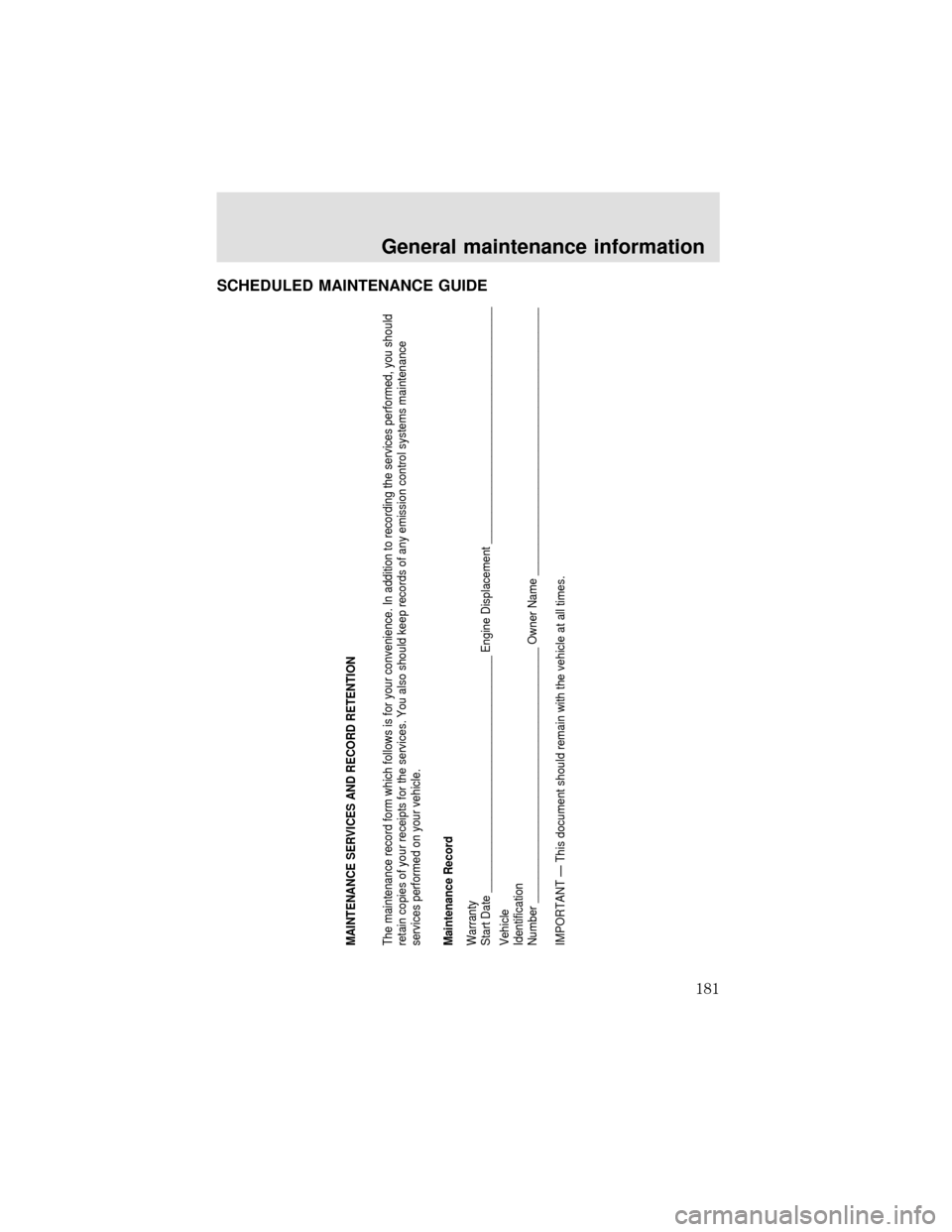
SCHEDULED MAINTENANCE GUIDE
MAINTENANCE SERVICES AND RECORD RETENTION
The maintenance record form which follows is for your convenience. In addition to recording the services performed, you should
retain copies of your receipts for the services. You also should keep records of any emission control systems maintenance
services performed on your vehicle.
Maintenance Record
Warranty
Start Date ______________________________________ Engine Displacement ______________________________________
Vehicle
Identification
Number _________________________________________ Owner Name ___________________________________________
IMPORTANT — This document should remain with the vehicle at all times.
General maintenance information
181
Page 182 of 208
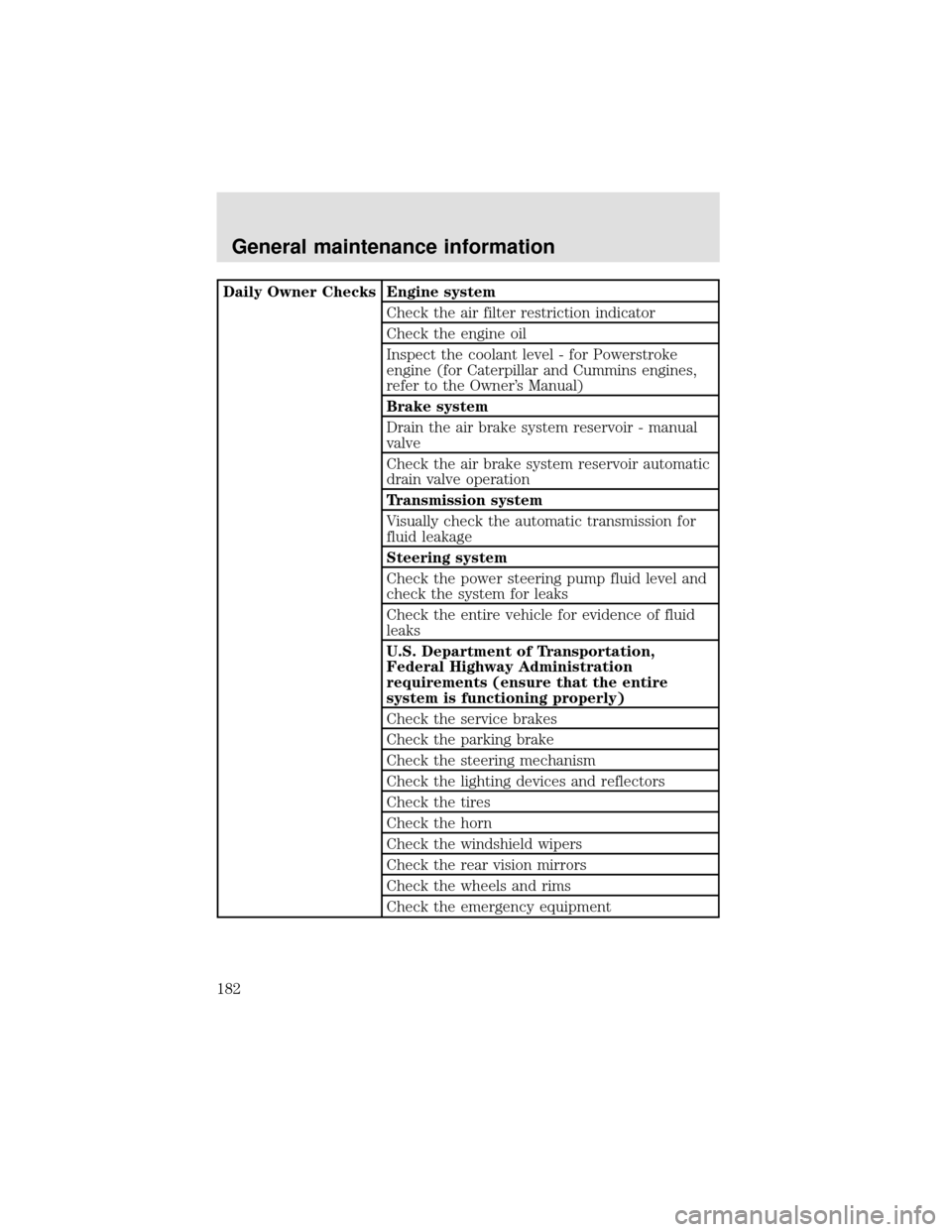
Daily Owner Checks Engine system
Check the air filter restriction indicator
Check the engine oil
Inspect the coolant level - for Powerstroke
engine (for Caterpillar and Cummins engines,
refer to the Owner’s Manual)
Brake system
Drain the air brake system reservoir - manual
valve
Check the air brake system reservoir automatic
drain valve operation
Transmission system
Visually check the automatic transmission for
fluid leakage
Steering system
Check the power steering pump fluid level and
check the system for leaks
Check the entire vehicle for evidence of fluid
leaks
U.S. Department of Transportation,
Federal Highway Administration
requirements (ensure that the entire
system is functioning properly)
Check the service brakes
Check the parking brake
Check the steering mechanism
Check the lighting devices and reflectors
Check the tires
Check the horn
Check the windshield wipers
Check the rear vision mirrors
Check the wheels and rims
Check the emergency equipment
General maintenance information
182
Page 183 of 208
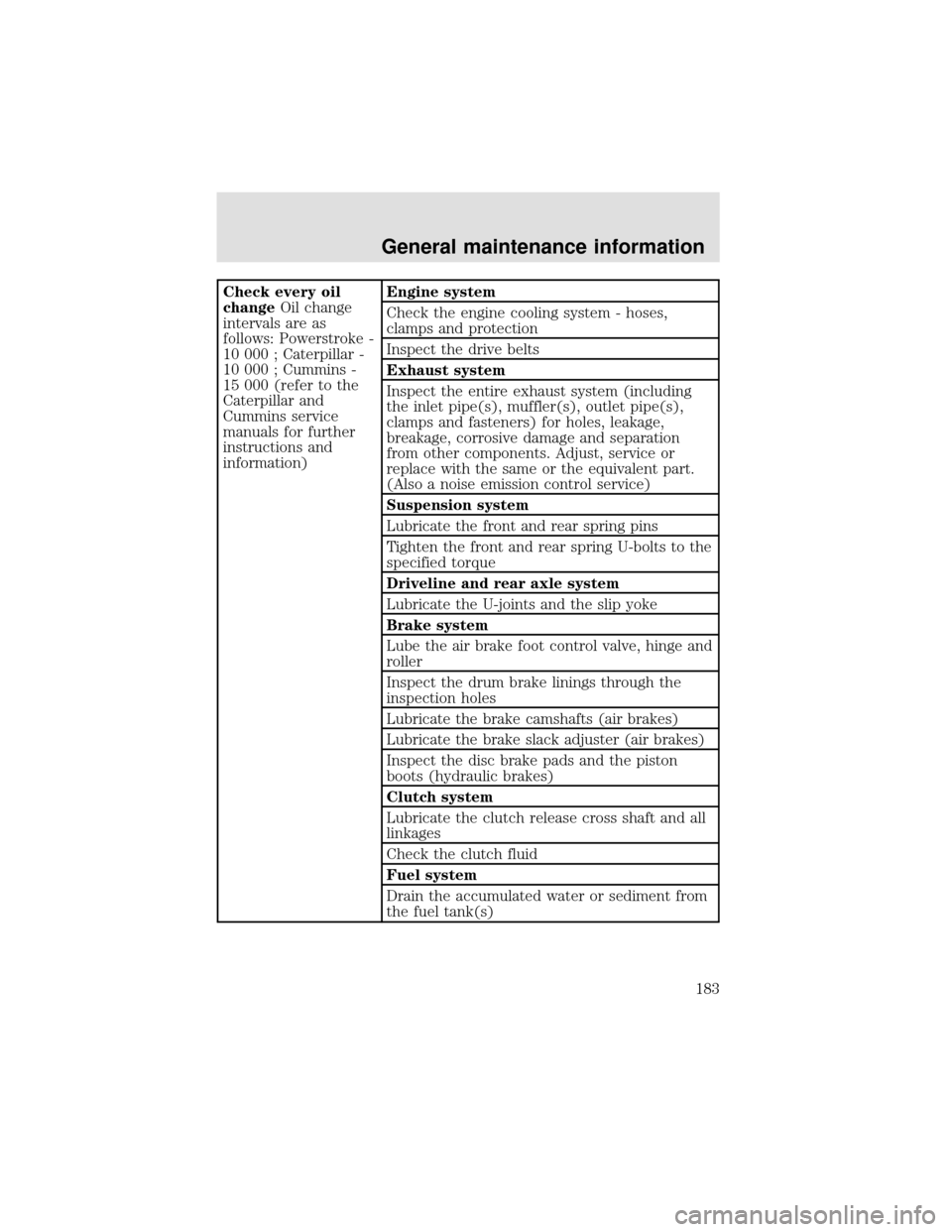
Check every oil
changeOil change
intervals are as
follows: Powerstroke -
10 000 ; Caterpillar -
10 000 ; Cummins -
15 000 (refer to the
Caterpillar and
Cummins service
manuals for further
instructions and
information)Engine system
Check the engine cooling system - hoses,
clamps and protection
Inspect the drive belts
Exhaust system
Inspect the entire exhaust system (including
the inlet pipe(s), muffler(s), outlet pipe(s),
clamps and fasteners) for holes, leakage,
breakage, corrosive damage and separation
from other components. Adjust, service or
replace with the same or the equivalent part.
(Also a noise emission control service)
Suspension system
Lubricate the front and rear spring pins
Tighten the front and rear spring U-bolts to the
specified torque
Driveline and rear axle system
Lubricate the U-joints and the slip yoke
Brake system
Lube the air brake foot control valve, hinge and
roller
Inspect the drum brake linings through the
inspection holes
Lubricate the brake camshafts (air brakes)
Lubricate the brake slack adjuster (air brakes)
Inspect the disc brake pads and the piston
boots (hydraulic brakes)
Clutch system
Lubricate the clutch release cross shaft and all
linkages
Check the clutch fluid
Fuel system
Drain the accumulated water or sediment from
the fuel tank(s)
General maintenance information
183
Page 184 of 208
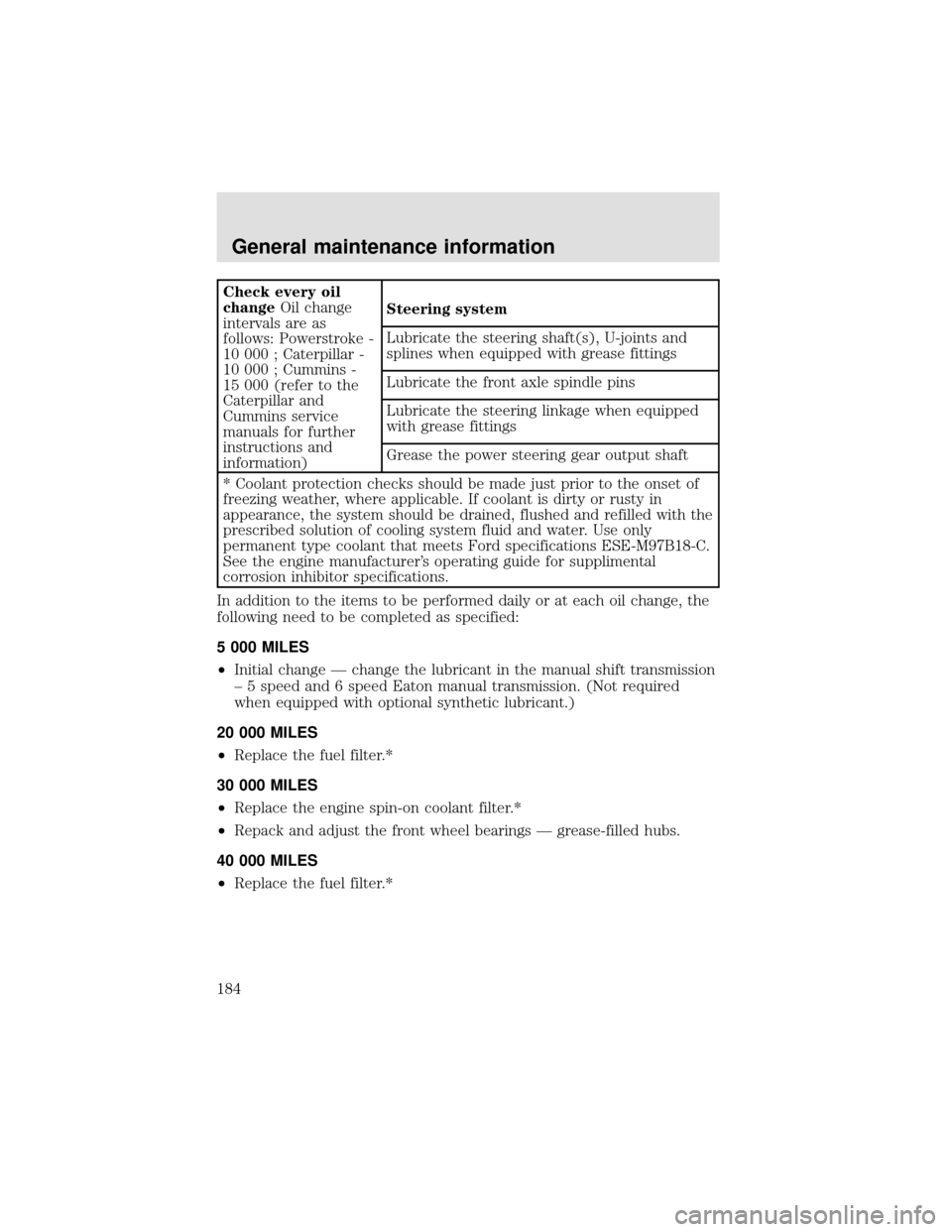
Check every oil
changeOil change
intervals are as
follows: Powerstroke -
10 000 ; Caterpillar -
10 000 ; Cummins -
15 000 (refer to the
Caterpillar and
Cummins service
manuals for further
instructions and
information)Steering system
Lubricate the steering shaft(s), U-joints and
splines when equipped with grease fittings
Lubricate the front axle spindle pins
Lubricate the steering linkage when equipped
with grease fittings
Grease the power steering gear output shaft
* Coolant protection checks should be made just prior to the onset of
freezing weather, where applicable. If coolant is dirty or rusty in
appearance, the system should be drained, flushed and refilled with the
prescribed solution of cooling system fluid and water. Use only
permanent type coolant that meets Ford specifications ESE-M97B18-C.
See the engine manufacturer’s operating guide for supplimental
corrosion inhibitor specifications.
In addition to the items to be performed daily or at each oil change, the
following need to be completed as specified:
5 000 MILES
•Initial change—change the lubricant in the manual shift transmission
–5 speed and 6 speed Eaton manual transmission. (Not required
when equipped with optional synthetic lubricant.)
20 000 MILES
•Replace the fuel filter.*
30 000 MILES
•Replace the engine spin-on coolant filter.*
•Repack and adjust the front wheel bearings—grease-filled hubs.
40 000 MILES
•Replace the fuel filter.*
General maintenance information
184
Page 185 of 208
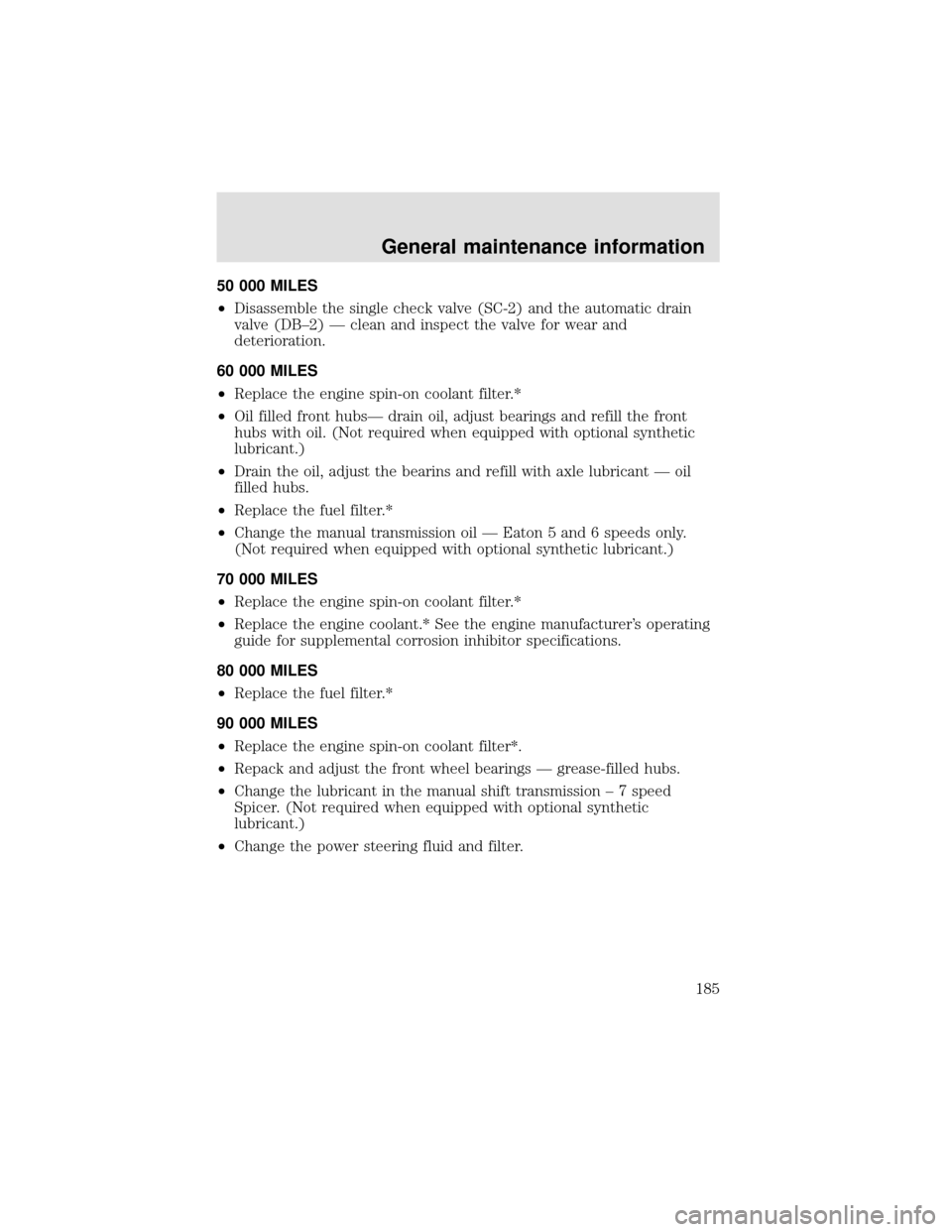
50 000 MILES
•Disassemble the single check valve (SC-2) and the automatic drain
valve (DB–2)—clean and inspect the valve for wear and
deterioration.
60 000 MILES
•Replace the engine spin-on coolant filter.*
•Oil filled front hubs—drain oil, adjust bearings and refill the front
hubs with oil. (Not required when equipped with optional synthetic
lubricant.)
•Drain the oil, adjust the bearins and refill with axle lubricant—oil
filled hubs.
•Replace the fuel filter.*
•Change the manual transmission oil—Eaton 5 and 6 speeds only.
(Not required when equipped with optional synthetic lubricant.)
70 000 MILES
•Replace the engine spin-on coolant filter.*
•Replace the engine coolant.* See the engine manufacturer’s operating
guide for supplemental corrosion inhibitor specifications.
80 000 MILES
•Replace the fuel filter.*
90 000 MILES
•Replace the engine spin-on coolant filter*.
•Repack and adjust the front wheel bearings—grease-filled hubs.
•Change the lubricant in the manual shift transmission–7 speed
Spicer. (Not required when equipped with optional synthetic
lubricant.)
•Change the power steering fluid and filter.
General maintenance information
185
Page 186 of 208
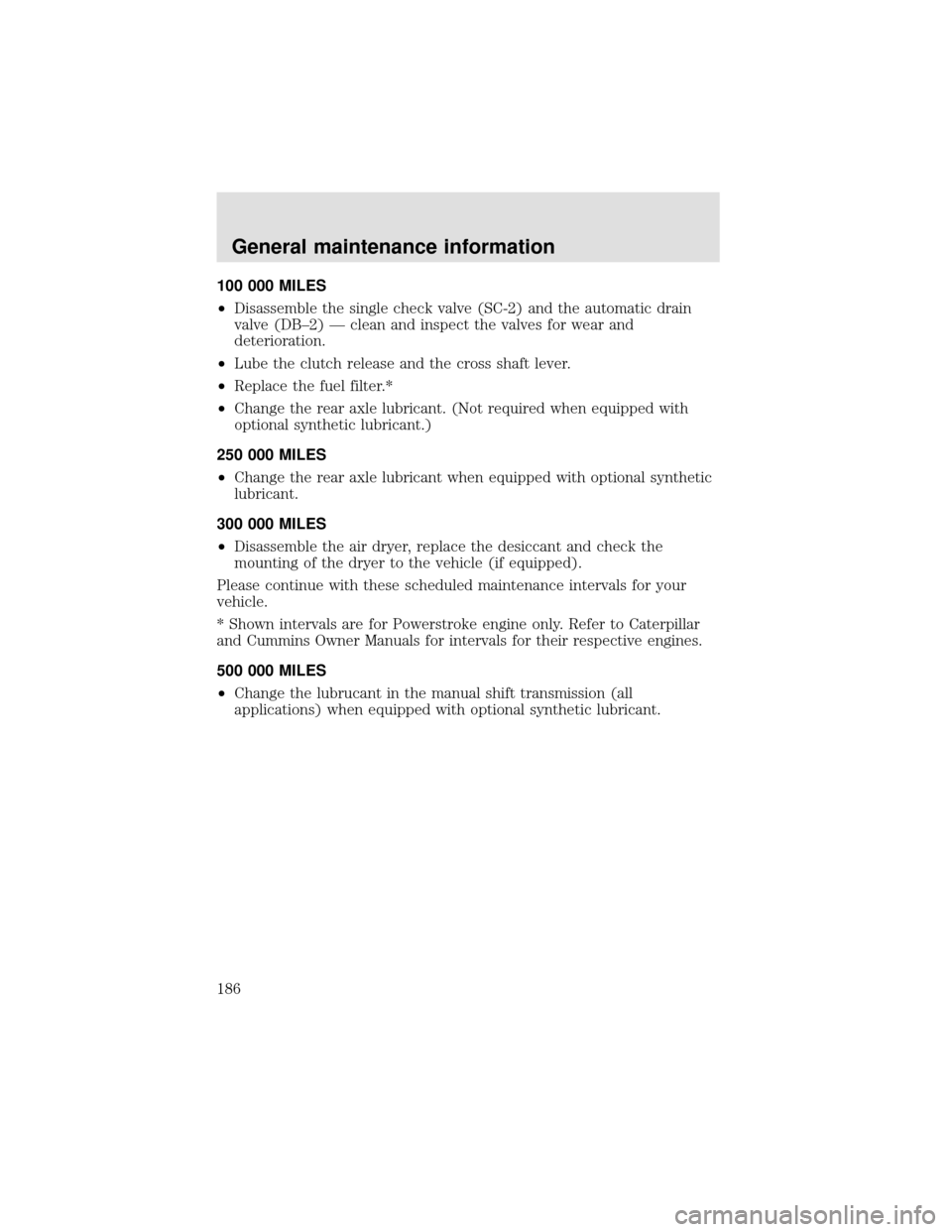
100 000 MILES
•Disassemble the single check valve (SC-2) and the automatic drain
valve (DB–2)—clean and inspect the valves for wear and
deterioration.
•Lube the clutch release and the cross shaft lever.
•Replace the fuel filter.*
•Change the rear axle lubricant. (Not required when equipped with
optional synthetic lubricant.)
250 000 MILES
•Change the rear axle lubricant when equipped with optional synthetic
lubricant.
300 000 MILES
•Disassemble the air dryer, replace the desiccant and check the
mounting of the dryer to the vehicle (if equipped).
Please continue with these scheduled maintenance intervals for your
vehicle.
* Shown intervals are for Powerstroke engine only. Refer to Caterpillar
and Cummins Owner Manuals for intervals for their respective engines.
500 000 MILES
•Change the lubrucant in the manual shift transmission (all
applications) when equipped with optional synthetic lubricant.
General maintenance information
186
Page 187 of 208
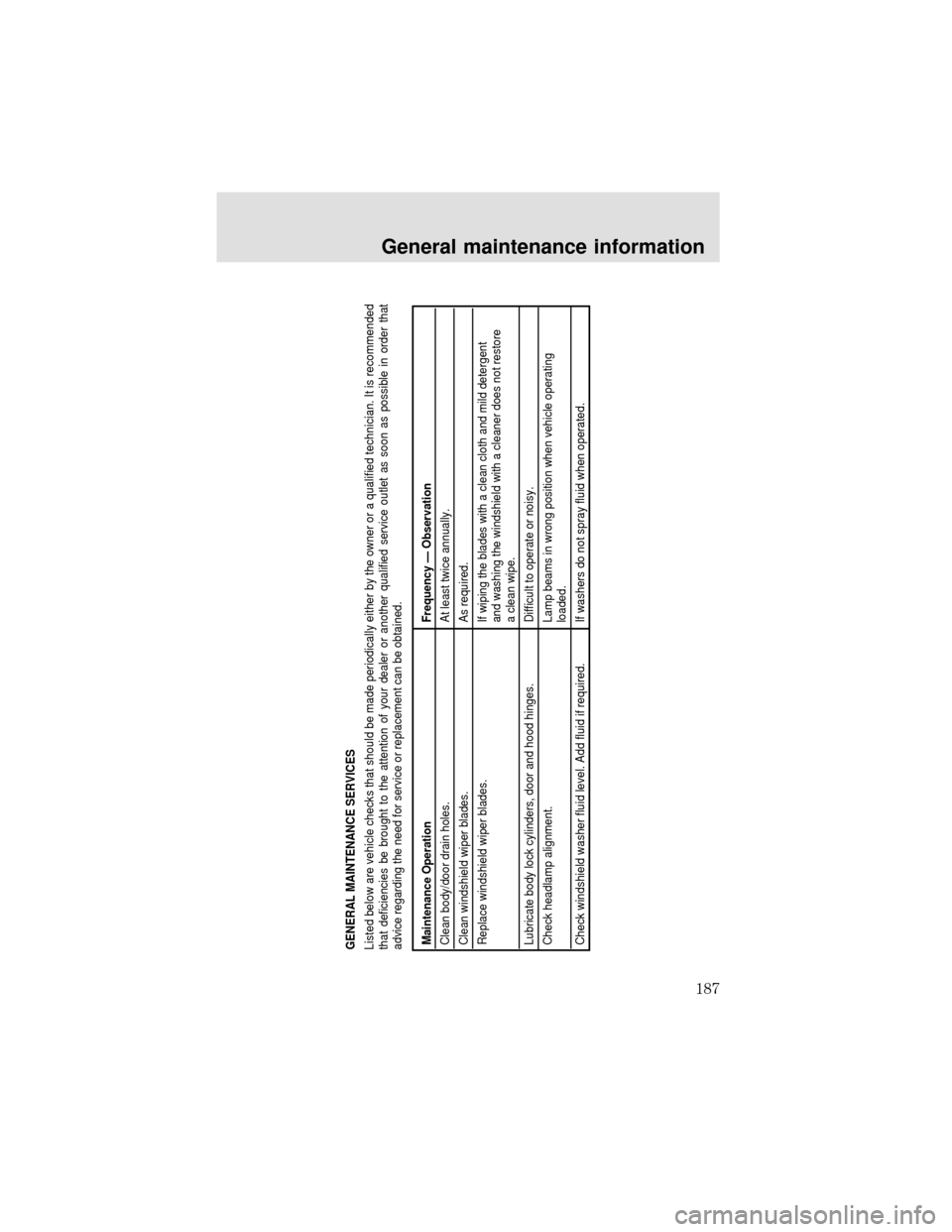
Maintenance Operation Frequency — ObservationClean body/door drain holes.
Clean windshield wiper blades.
Replace windshield wiper blades.
Lubricate body lock cylinders, door and hood hinges.
Check headlamp alignment.
Check windshield washer fluid level. Add fluid if required.At least twice annually.
As required.
If wiping the blades with a clean cloth and mild detergent
and washing the windshield with a cleaner does not restore
a clean wipe.
Difficult to operate or noisy.
Lamp beams in wrong position when vehicle operating
loaded.
If washers do not spray fluid when operated. GENERAL MAINTENANCE SERVICES
Listed below are vehicle checks that should be made periodically either by the owner or a qualified technician. It is recommended
that deficiencies be brought to the attention of your dealer or another qualified service outlet as soon as possible in order that
advice regarding the need for service or replacement can be obtained.
General maintenance information
187
Page 188 of 208
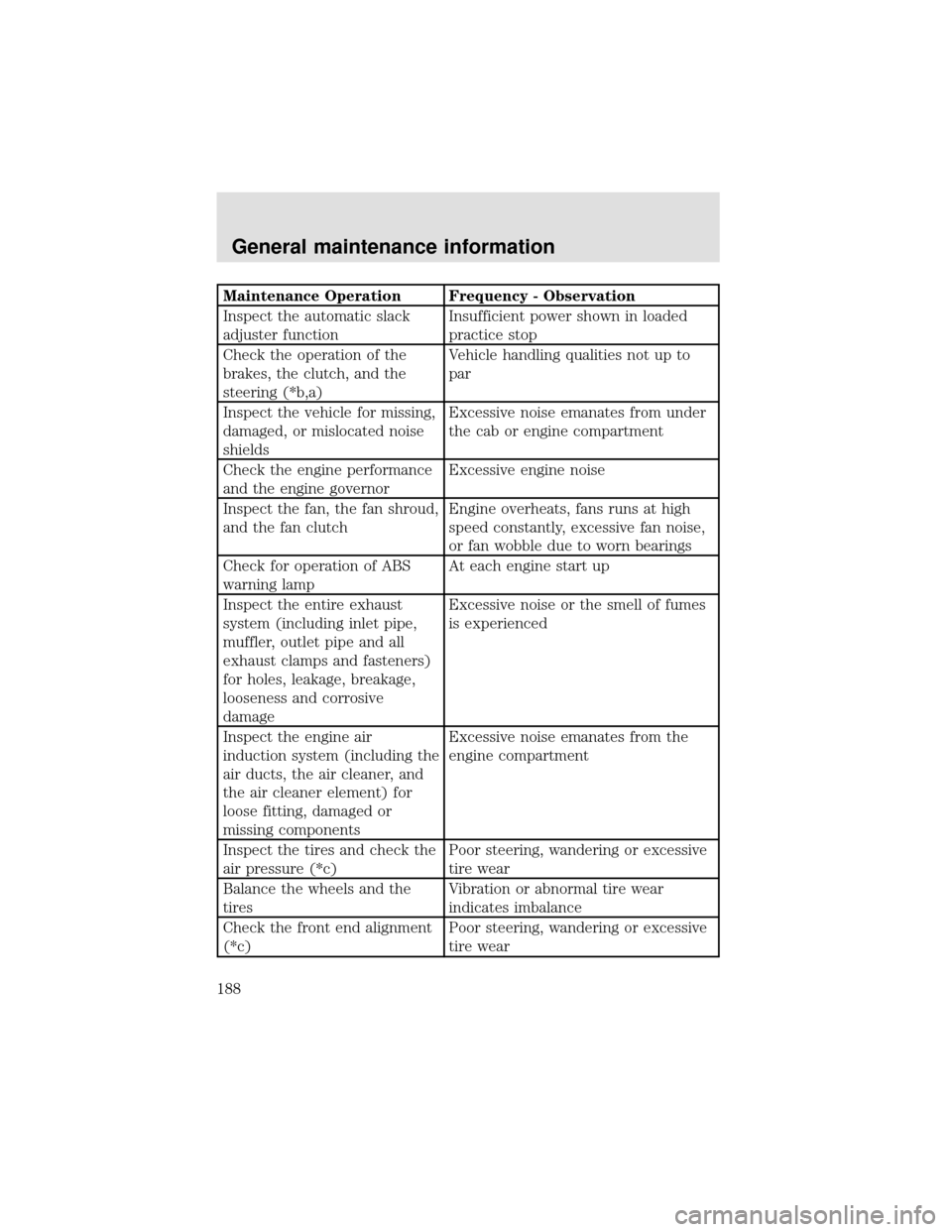
Maintenance Operation Frequency - Observation
Inspect the automatic slack
adjuster functionInsufficient power shown in loaded
practice stop
Check the operation of the
brakes, the clutch, and the
steering (*b,a)Vehicle handling qualities not up to
par
Inspect the vehicle for missing,
damaged, or mislocated noise
shieldsExcessive noise emanates from under
the cab or engine compartment
Check the engine performance
and the engine governorExcessive engine noise
Inspect the fan, the fan shroud,
and the fan clutchEngine overheats, fans runs at high
speed constantly, excessive fan noise,
or fan wobble due to worn bearings
Check for operation of ABS
warning lampAt each engine start up
Inspect the entire exhaust
system (including inlet pipe,
muffler, outlet pipe and all
exhaust clamps and fasteners)
for holes, leakage, breakage,
looseness and corrosive
damageExcessive noise or the smell of fumes
is experienced
Inspect the engine air
induction system (including the
air ducts, the air cleaner, and
the air cleaner element) for
loose fitting, damaged or
missing componentsExcessive noise emanates from the
engine compartment
Inspect the tires and check the
air pressure (*c)Poor steering, wandering or excessive
tire wear
Balance the wheels and the
tiresVibration or abnormal tire wear
indicates imbalance
Check the front end alignment
(*c)Poor steering, wandering or excessive
tire wear
General maintenance information
188
Page 189 of 208
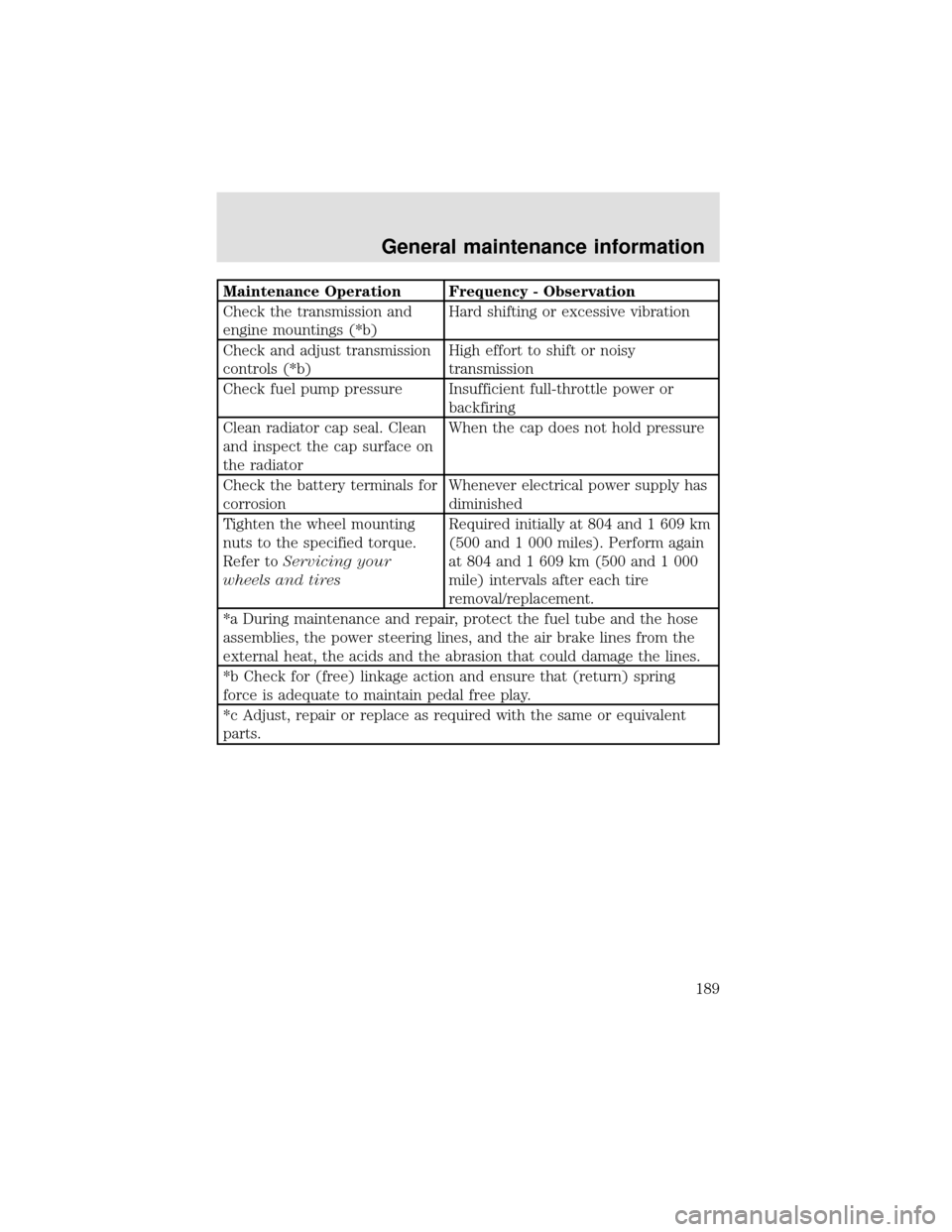
Maintenance Operation Frequency - Observation
Check the transmission and
engine mountings (*b)Hard shifting or excessive vibration
Check and adjust transmission
controls (*b)High effort to shift or noisy
transmission
Check fuel pump pressure Insufficient full-throttle power or
backfiring
Clean radiator cap seal. Clean
and inspect the cap surface on
the radiatorWhen the cap does not hold pressure
Check the battery terminals for
corrosionWhenever electrical power supply has
diminished
Tighten the wheel mounting
nuts to the specified torque.
Refer toServicing your
wheels and tiresRequired initially at 804 and 1 609 km
(500 and 1 000 miles). Perform again
at 804 and 1 609 km (500 and 1 000
mile) intervals after each tire
removal/replacement.
*a During maintenance and repair, protect the fuel tube and the hose
assemblies, the power steering lines, and the air brake lines from the
external heat, the acids and the abrasion that could damage the lines.
*b Check for (free) linkage action and ensure that (return) spring
force is adequate to maintain pedal free play.
*c Adjust, repair or replace as required with the same or equivalent
parts.
General maintenance information
189
Page 190 of 208
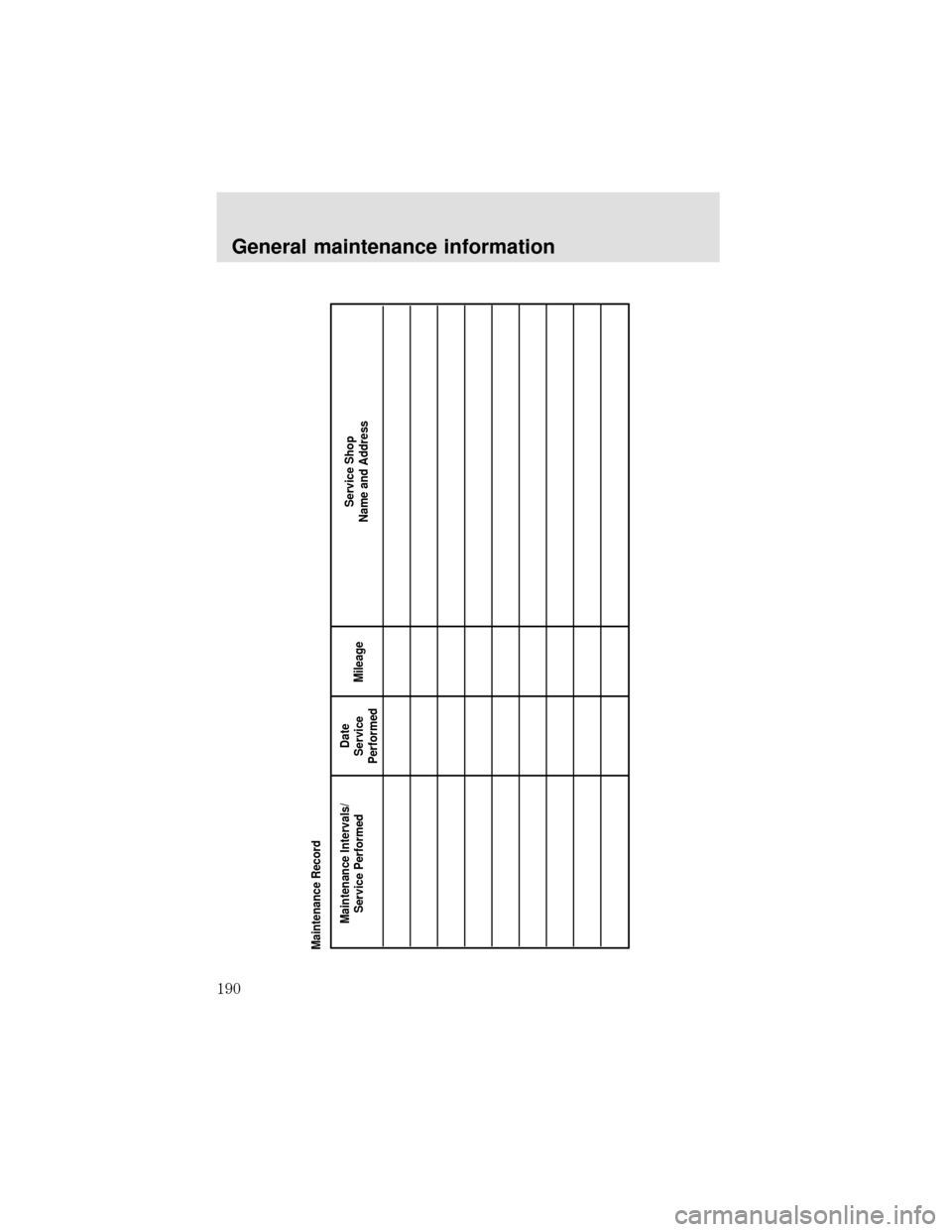
Maintenance Intervals/
Service PerformedService Shop
Name and Address Date
Service
PerformedMileage Maintenance Record
General maintenance information
190